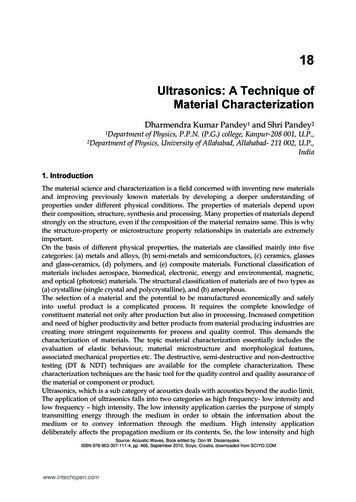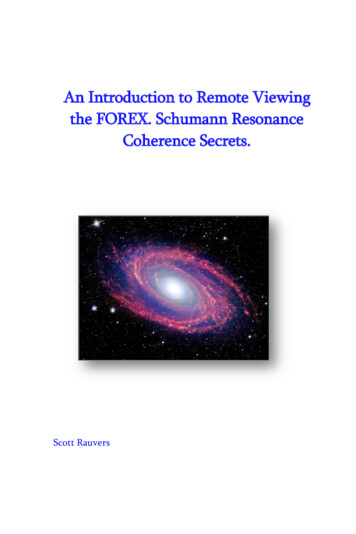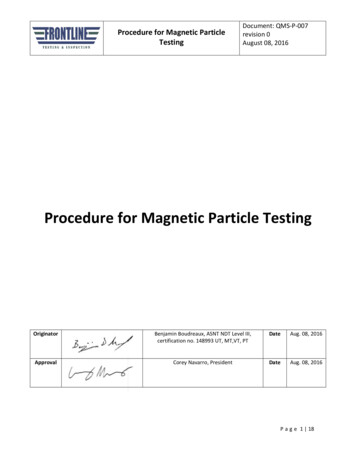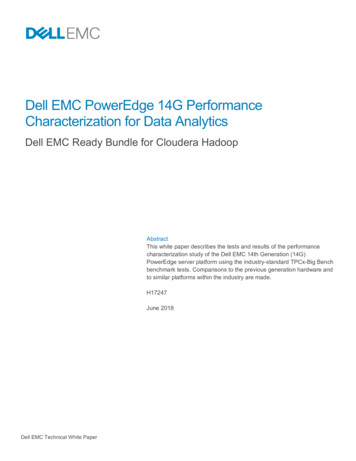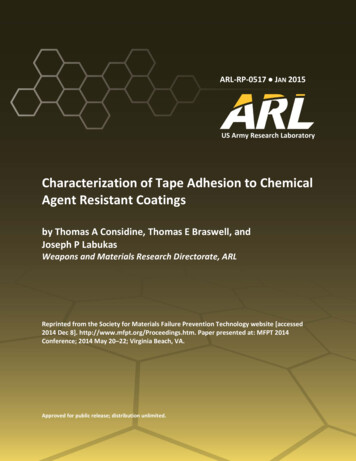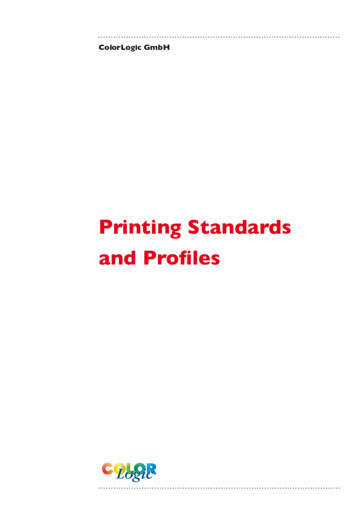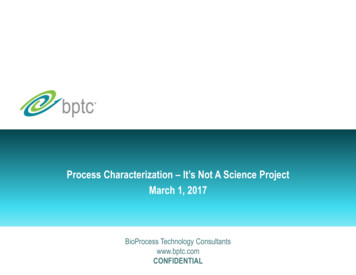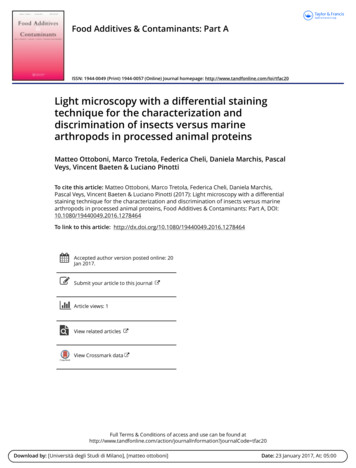
Transcription
Food Additives & Contaminants: Part AISSN: 1944-0049 (Print) 1944-0057 (Online) Journal homepage: http://www.tandfonline.com/loi/tfac20Light microscopy with a differential stainingtechnique for the characterization anddiscrimination of insects versus marinearthropods in processed animal proteinsMatteo Ottoboni, Marco Tretola, Federica Cheli, Daniela Marchis, PascalVeys, Vincent Baeten & Luciano PinottiTo cite this article: Matteo Ottoboni, Marco Tretola, Federica Cheli, Daniela Marchis,Pascal Veys, Vincent Baeten & Luciano Pinotti (2017): Light microscopy with a differentialstaining technique for the characterization and discrimination of insects versus marinearthropods in processed animal proteins, Food Additives & Contaminants: Part A, DOI:10.1080/19440049.2016.1278464To link to this article: epted author version posted online: 20Jan 2017.Submit your article to this journalArticle views: 1View related articlesView Crossmark dataFull Terms & Conditions of access and use can be found tion?journalCode tfac20Download by: [Università degli Studi di Milano], [matteo ottoboni]Date: 23 January 2017, At: 05:00
Publisher: Taylor & Francis & Informa UK Limited, trading as Taylor & FrancisJournal: Food Additives & Contaminants: Part ADOI: 10.1080/19440049.2016.1278464Light microscopy with a differential staining technique for the characterizationand discrimination of insects versus marine arthropods in processed animalproteinsMatteo Ottoboni1, Marco Tretola1, Federica Cheli1, Daniela Marchis2, Pascal Veys3,Vincent Baeten3, Luciano Pinotti11 Department of Health, Animal Science and Food Safety VESPA, Università degliStudi di Milano, Milan, Italy.2 National Reference Laboratory on animal proteins in feed, Istituto ZooprofilatticoSperimentale di Piemonte, Liguria e Valle D’Aosta, Italy.3 Food and Feed Quality Unit, Valorisation Department, Walloon AgriculturalResearch Centre CRA-W, Gembloux, Belgium.Corresponding author: Prof. Luciano Pinotti e-mail: luciano.pinotti@unimi.itThe aim of this study was to evaluate the use of light microscopy with adifferential staining technique for the discrimination of insect material frommarine arthropods – classified as fishmeal. Specifically, three samples of singlespecies insect material, Hermetia illucens (HI), Bombyx mori (BM) and Tenebriomolitor (TM) and two samples of marine arthropods, shrimp material and krill,have been analysed and compared after staining by two reagents to enhancefragment identification. Alizarin Red (AR) and Chlorazol black (CB), which reactrespectively with calcium salts and chitin, were tested for their potential efficacyin distinguishing between insect and marine materials. Results indicated that ARfailed to stain HI, BM and TM materials. By contrast, the three insect speciesmaterials tested (HI, BM and TM) were stained by CB. When shrimp fragmentsand krill were considered, AR and CB stained marine materials reddish-pink andlight blue to black, respectively. By combining these results it can be suggested
that CB staining may efficiently be used to mark insect materials; AR does stainshrimp fragments but does not stain the tested insect material, indicating apossible approach for discriminating between insects and marine arthropods.However, since the present study has only been done on pure materials and on asmall set of samples, possible implementation of this technique still needs to beconfirmed in complex matrices such as compound feed.Keywords: insect meals; arthropods; microscopy; staining; identification.IntroductionIn several Member States within the European Union, numerous studies are running oninsect rearing and biomass production for feed purpose. Ongoing researches on insectsas feed are mainly focused on types of feed substrates to raise the insects, nutritionalvalues of the produced insects, diet formulations, and animal performance when thesematerials are fed (Makkar, 2014; Barroso, 2014; van Huis 2013; Veldkamp et al. 2015;Sánchez-Muros et al., 2014; Rumpold and Schlüter, 2013). The potential use of insectmeal as a feed ingredient for farmed animals has been proposed mainly as a proteinsource (Veldkamp et al., 2015).However, the major barrier to growth of the edible insect sector is the absence ofprecise and insect-focused legislation, as reported elsewhere (FAO, 2013; LahteenmakiUutela & Grmelova, 2016).As reported by the recent EFSA (2015) document “Risk profile of insects as food andfeed”, there are several legislative requirements that impact the use of insects as foodand feed (at EU level). Currently, the feed ban provisions of Regulation (EC) No999/2001 (TSE Regulation) do not allow insect meals to be fed to farmed animals dueto lack of a safety profile. Furthermore, with respect to feed/substrate for insects, AnnexIII to Regulation (EC) No 767/2009 prohibits the feeding of faeces and separateddigestive tract content even though these materials are used in other parts of the worldas substrates in insect production. These aspects are relevant for insect material becauseinsect meals should be considered as processed animal proteins (PAPs). The legislativeframework specifically related to insects used as food and feed, however, is still underdevelopment. Beyond categorization and destination concerns about insect meals, a
further step in defining future insect legislation is the implementation of analyticalmethods, for their traceability and identification.Nowadays, insect materials in feed and food matrices have been considered ascontaminants and/or extraneous matter. The standard method for determining insectfragments in flours for human consumption (AOAC method 993.26), is based on insectfragments extraction by acid digestion and flotation, but this technique is laborious andtime consuming. There are a few methods that have sought to determine insect fragmentcounts using enzyme-linked immunosorbent assays (ELISA) (Quinn et al., 1992;Schatzki et al., 1993; Brader et al., 2002), DNA finger printing (Balasubramanian et al.,2007) or near-infrared spectroscopy (NIRS) (Perez-Mendoza et al., 2003). A furtherapproach has been proposed by Bhuvaneswari and co-workers (2011). In the latterstudy, authors have compared the speck counts from an electronic speck counter, acidhydrolysis and flotation (AOAC method 993.26), and near-infrared (NIR) hyperspectralimaging in experimentally contaminated semolina. However, in this case too thedetection of insect as extraneous matters was the goal.Assuming that insect meals will be considered as PAPs, and therefore as a feedingredient, the already existing methods for PAP detection and identification can beconsidered as a robust starting point. In the EU, although several techniques have beenproposed (van Raamsdonk et al., 2012; Veys et al., 2012; Fumière et al., 2009; Ottoboniet al., 2014; Pinotti et al., 2013; Tena et al., 2014; Pinotti et al., 2016), only twomethods are allowed within the framework of official controls for the detection ofanimal proteins in feed, namely light microscopy and polymerase chain reaction (PCR)(Regulation EC No 152/2009; Regulation EU No 51/2013). Both methods have beenvalidated for proper implementation of the feed ban.In the case of light microscopy, Alizarin Red (AR) has been authorized as a stainingreagent in Reg. EU 51/2013 (European Commission, 2013b) for the official control offeed. The staining reagent colours some major mineral constituents, like hydroxyapatiteand calcium phosphates (e.g., tricalcium phosphate), both well represented in bones(EURL-AP, 2013; Liu et al., 2011). Assuming an adaptation of the microscopic methodfor other PAPs, such as insect material, several aspects must be considered. First, thenature of the insect materials, which is variable (Makkar et al., 2014). Insect particlespresent different features according to the physiological stage of the insects (e.g. larvae
or adult state) used for producing the meals (Finke, 2009). Second, absence of bones aswell as presence of an exoskeleton (e.g. cuticle structure), make these materials in somecircumstance quite close to marine arthropods (e.g. shrimps). In term of compositionhowever, shrimp and krill exoskeleton is naturally rich in calcium (Watkins et al., 1982;Chen et al., 2009), while a small amount of calcium is present in Hermetia illucenslarvae (Finke et al., 2013). This implies that authorized staining reagents, like AR,would not be suitable for insect materials.In this context, chlorazol black (CB) is a stain with a high affinity for chitin, a uniquestructural homopolymer polysaccharide of β-[1,4]-linked D-N-acetylglucosamine(Thomas et al., 2008). As reported by Finke (2009) Hermetia illucens is rich in chitin,while for the other insect material its presence can be variable (Makkar 2014). Chitin incombination with calcium deposits is also one of the main components in shrimp andkrill exoskeletons (Watkins et al., 1982; Al Sagheer et al., 2009; Chen et al., 2009 Nicoland Hosie, 1993). This makes CB a potential staining reagent for both insect and marinearthropod identification.Starting from these assumptions, the aim of this study was to evaluate the use of lightmicroscopy and the potential of two different staining reagents, namely AR and CB, forthe discrimination of insect PAP against marine arthropods – classified as fishmeal.Material and methodNine different animal meals samples were selected. Specifically, 7 samples of insectmaterial and 2 samples of marine arthropods were used. Insect samples were obtainedfrom the following species: black soldier fly larvae (Hermetia illucens, 4 samplesprovided by European Union Reference Laboratory for Animal Proteins infeedingstuffs, EURL-AP), silkworm (Bombyx mori, 1 sample provided by Centro diReferenza Nazionale per la Sorveglianza e il Controllo degli Alimenti per gli Animali,C.Re.A.A.), and mealworm (Tenebrio molitor, 1 sample provided by EURL-AP and 1sample provided by C.Re.A.A.). All insect samples were pure materials obtained underexperimental and lab scale conditions. In the case of marine arthropods a shrimp mealand a krill meal sample were used, both provided by EURL-AP. All dried pure sampleswere ground with a mortar and pestle. Subsequently, for each sample at least 3microscopic slides were prepared using Norland Optical adhesive 65 or glycerol as the
embedding agent as indicated in the official method for the determination ofconstituents of animal origin in feed. After curing, slides were examined using acompound microscope (Olympus BX41, Tokyo, Japan or Carl Zeiss Axio Imager A1) atseveral magnifications under bright field conditions. Both insect and marine fragmentimages were acquired using a digital camera (CoolSNAP-Pro cf Color or AxioCamMRc coupled with a 0.63 port).In a second step and in order to enhance fragment identification, all samples wereanalyzed using AR and CB as staining reagents. Briefly AR staining (Color IndexNumber 58005, Sigma-Aldrich 3050 Spruce Street, Saint Louis, MO 63103, USA) wasperformed according to Annex VI of EC/152/2009. The stained material was thenplaced in an oven at 68 C until completely dry. Subsequently, for each sample at least 3microscopic slides were prepared using Norland Optical adhesive 65 or glycerol as theembedding agent. In the case of CB stain (Color Index Number 30235, Sigma-Aldrich3050 Spruce Street, Saint Louis, MO 63103, USA), dried samples (100 mg) weretransferred into a glass test tube and rinsed twice with approximately 5 ml ethanol (eachtime a vortex was used; the solvent was allowed to settle approximately one minute andthen poured off). Before using this staining reagent, the sample was bleached by addingat least 1 ml sodium hypochlorite solution. The reaction was allowed to continue for 10minutes. Next, the tube was filled with water, the sample was left to settle for 2-3minutes, and the water and any suspended particles were poured off. The sample wasrinsed twice more with approximately 10 ml of water (each time a vortex was used; themixture was allowed to settle approximately one minute and the supernatant pouredoff). The sample was rinsed once with approximately 5 ml acetone, vortexed anddecanted, left to settle, and then the acetone was poured off. A few drops (depending onthe amount of residue) of the CB solution were added. The mixture was shaken and lefta few seconds for the staining to occur reaction. The coloured sediment was rinsedtwice with approximately 5 ml ethanol followed by three rinses with acetone (each timea vortex was used; the supernatant was allowed to settle approximately one minute andthen poured off). The sample was placed in an oven at 68 C until completely dry.Results and discussionResults obtained in the present study are reported in Figure 1 (from A to I) for insectmaterials and in Figure 2 (from A to F) for marine arthropods materials. For each
sample a selected picture without (microscopic slides mounted with Norland Opticaladhesive 65 or glycerol) or with specific staining reagents have been presented. Ingeneral, when any staining reagent had been used, distinguishing between insect andmarine arthropods materials was difficult. No substantial differences were observedbetween Hermetia illucens, Tenebrio Molitor and Bombyx mori vs krill and shrimpssamples. As shown in Figures 1A to 1C Hermetia illucens fragments of the exoskeletonare characterized by cell-like structures (Fig. 1A, 1B and 1C) four- or five-sided withthick walls and a broad lumen. This lumen, as observed in surface view, is wider thanthe thick walls (see arrowhead in Figure 1C). The structure of the thick walls gives thecells a honeycomb-like appearance. Hermetia illucens material colours ranges fromgrey-cream to brown and dark. Bristles, generally long, narrow and yellow-brownish,have also been observed in Hermetia illucens material (Fig. 1A, 1B and 1C). Notably,bristles can present in different colours, from the proximal part to the distal one or fromthe inner part to the peripheral one. Colour moves through yellow shades, followed by ablack and yellow line in the middle. In the same preparation other pyramidal structureshave been observed, but their precise characterization is difficult and speculative at thisstage: further investigation are needed in order to define their specific features.In Bombyx mori cuticular fragments (Fig. 1D, 1E and 1F) a similar pattern to thatreported for HI has been observed, color moves from yellow (background) to brown(broad lumen). Differently to HI no bristles were observed in Bombyx mori samples.In the case of Tenebrio molitor (Fig. 1G, 1H and 1I) material no specific pattern norbristles were observed. However in all TM fragments rare dark pigmented brownishdots were observed. These structures are similar to glandular pores in ventral abdominalcuticle of Tenebrio molitor larvae described by Locke (1961). Tenebrio molitor materialvaried from grey to deep amber-brown in color.Marine arthropod material (shrimp and krill) is presented in Figures 2A to 2F. Under themicroscope, it can be observed that when any staining reagent had been used(microscopic slides mounted with Norland Optical adhesive 65 or glycerol) fragmenttransparency could be seen. Most of the features observed not only are in line with theliterature (Makowski et al., 2011), but in some cases quite similar to those observed ininsect samples. Krill and shrimps fragments were characterized by the presence ofmore-or-less transparent particles of the chitinous shells. These particles showed very
fine lines intersecting at random angles and extending across the whole particle.Occasionally, lines would connect across several other lines, forming triangles and othergeometric shapes (Fig. 2D and 2E). In some areas, there may be cross-hatching (Fig.2A, 2D, 2E and 2F). These findings are in line with the description of shrimp and krillmeals reported by Makowski et al. (2011).Results obtained with AR staining of insect fragments are also reported in Figure 1. Itcan be observed that no staining reaction was observed for insect fragments. AR stainscalcium ions in several mineral forms. Specifically, it has been reported that thisstaining reacts principally with hydroxyapatite (contained in bone) but also withcalcium phosphates (e.g., tricalcium phosphate) (EURL-AP, 2013). Accordingly, thehypothesis behind this experiment was that these insect species could be coloured usinga calcium specific stain. Indeed, calcium content in Hermetia illucens larvae can behigher than 75 g/kg DM (Makkar et al., 2014). Nevertheless, after staining Hermetiaillucens material with the alizarin solution, no coloration was observed (Fig. 1A). Thisphenomenon can be ascribed to different factors: i) there were no calcium salts presentin HI larvae sample; ii) the mineral form of calcium contained in this insect species doesnot react with AR; iii) the calcium salts were not accessible to the dye, because forinstance of the presence of lipid-like waxes; iv) the fact that in the present study insectmaterial of each species was collected at larval stages that do not have a fullydifferentiated cuticle possibly not containing calcium ions. However, a combination ofall factors cannot be excluded. The same absence of staining was found for silkworm(Bombyx mori, 1 sample), and mealworm (Tenebrio molitor, 1 sample) (Fig. 1D and 1Grespectively), even though some differences in calcium content, compared to HI, havebeen reported in literature for these species (Makkar et al., 2014).With regard to the CB stain test performed on HI, results obtained evidenced that theinsect materials stained dark black (Fig. 1B). Chlorazol black is a dye with a highaffinity for chitin (Thomas et al., 2008), which is abundant in Hermetia illucens (Finke,2009). With silkworms and mealworms the same reaction has been observed: insectmaterial became blue/black (Fig. 1E and 1H).Moving to marine arthropods, it can be observed that AR and CB stain tests, colouredthe shrimp fragments reddish-pink (Fig. 2A) and dark black (Fig. 2B), respectively.These results were expected because the shrimp exoskeleton is naturally rich in both
chitin and calcium (Watkins et al., 1982; Al Sagheer et al., 2009). In the case of krill,fragments have shown a reddish-pink staining for AR staining and a light blue/black forCB staining. When using AR, results obtained for krill were comparable to shrimp (Fig.2D), but different for Chlorazol black. The CB staining has shown a limited reaction inthe krill sample (see Fig. 2E). This latter aspect merits further investigations, becausethe assumption is that both marine materials are characterized by similar compositions.By combining these results (Table 1), it can be suggested that CB stain is not adequateto distinguish between terrestrial (insect) and marine (shrimp and krill) arthropods: bothmaterials get stained with CB. This represents a limit to the potential of these stainingagents for insect material identification in complex matrices such as compound feed.Alizarin Red does stain shrimp fragments but did not stain the tested insect material,indicating a possible approach for discriminating between terrestrial and marinearthropods. However, further progress in this area requires the establishment of asufficiently large and representative reference materials bank, which should also containheat treated and processed insect meals. In fact, one of the weakness of this study wasnot only the limited number of samples tested, but also the mild heat treatment (dryingonly) that they have received. This was principally due to the difficulty in obtainingpure insect samples. In spite of that, the results presented here may represent a goodstarting point for future research in the field of feed safety.ConclusionThis study has investigated the use of light microscopy and two selected stains in orderto enhance features that could allow distinguishing insect material from marinearthropods materials. Results obtained in the present study indicated that microscopyhas some potential for this when specific staining reagents are used. By contrast, whenany staining reagent was used (microscopic slides mounted with Norland Opticaladhesive 65 or glycerol), distinguishing between insect and marine arthropods materialswas difficult. No substantial differences were observed between Hermetia illucens,Tenebrio Molitor and Bombyx mori vs krill and shrimps samples. The use of Alizarinred can help in the recognition of insect fragments in comparison with marinearthropods, although with some limits. Composition of insect meals, which is stronglycorrelated to physiological state (i.e. larval vs adult form) and growth condition (i.e.substrate) of the insect, may affect staining reactions and in turn identification of the
material. Thus, although the tools proposed here appear promising, a combinedapproach which include molecular methods (PCR) or others (e.g. NIRM), is thereforerecommended.ReferencesAl Sagheer FA, Al-Sughayer MA, Muslim S, Elsabee MZ. 2009. Extraction andcharacterization of chitin and chitosan from marine sources in Arabian Gulf.Carbohydrate Polymers 77, 410–419.AOAC 993.26. Association Of Analytical Communities. 1996. Test Method: Light Filthin Whole Wheat Flour – Flotation M.Barroso FG, de Haro C, Sánchez-Muros MJ, Venegas E, Sánchez AM, Bañón CP.2014. The potential of various insect species for use as food for fish.Aquaculture 422–423, 193–201.Balasubramanian A, Jayas DS, Fernando WGD, Li G, White NDG. 2007. Sensitivityanalysis of DNA fingerprinting technique for detecting insect fragments inwheat flour. Canadian Biosystems Engineering 49, 41-45.Brader B, Lee RC, Plarre R, Burkholder WG, Kitto BG, Kao C, Polston L, Dorneanu E,Szabo I, Mead B, Rouse B, Sullins D, Denning R. 2002. A comparison ofscreening methods for insect contamination in wheat. Journal of Stored ProductsResearch 38, 75-86.Bhuvaneswari K, Fields PG, White NDG, Sarkar AK, Singh CB, Jayas DS. 2011.Image analysis for detecting insect fragments in semolina. Journal of StoredProducts Research 47, 20-24.Chen YC, Tou JC, Jaczynski J. 2009. Amino acid and mineral composition of proteinand other components and their recovery yields from whole Antarctic krill(Euphausia superba) using isoelectric solubilization/precipitation. JOURNALOF FOOD SCIENCE 74 (2), 31-39.EFSA, 2015. European Food Safety Authority. Risk profile related to production andconsumption of insects as food and feed. EFSA Journal 13 (10), 4257.EURL-AP, 2013. European Union Reference Laboratory for Animal Proteins infeedingstuffs, EURL-AP Standard Operating Procedure, Use of stainingreagents. Publication date 28.03.2013. Available 20use%20of%20staining%20reagents%20V1.0.pdf.
European Commission, 2001. Regulation No. 999/2001 of 22 May 2001 laying downrules for the prevention, control and eradication of certain transmissiblespongiform encephalopathies. In: Official Journal, L 147, 31/05/2001, pp 1-40.European Commission, 2009a. Regulation No. 152/2009 of 27 January 2009 layingdown the methods of sampling and analysis for the official control of feed. In:Official Journal, L54, 26/02/2009 2009. pp. 1–130.European Commission, 2009b. Regulation No. 767/2009 of 13 July 2009 on the placingon the market and use of feed, amending European Parliament and CouncilRegulation (EC) No 1831/2003 and repealing Council Directive 79/373/EEC,Commission Directive 80/511/EEC, Council Directives 82/471/EEC,83/228/EEC, 93/74/EEC, 93/113/EC and 96/25/EC and Commission Decision2004/217/EC. In Official Journal, L 229, 1.9.2009, pp 1-28.European Commission, 2013a. Regulation No. 56/2013 of 16 January 2013 amendingAnnexes I and IV to Regulation No 999/2001 laying down rules for theprevention, control and eradication of certain transmissible spongiformencephalopathies. In: Official Journal, L21, 24/01/2013. pp. 3–16.European Commission, 2013b. Regulation No. 51/2013 of 16 January 2013 amendingRegulation No 152/2009 as regards the methods of analysis for thedetermination of constituents of animal origin for the official control of feed. In:Official Journal, L 20, 23/01/2013. pp. 33–43.FAO, 2013. Food and Agriculture Organization of the United Nations. THE STATE OFFOOD AND AGRICULTURE 2013, Rome. Available tmFinke MD. 2009. Estimate of Chitin in Raw Whole Insects. Zoo Biology 26, 105-115.Finke MD. 2013. Complete Nutrient Content of Four Species of Feeder Insects. ZooBiology 32, 27-36.Fumière O, Veys P, Boix A, Baeten V, Berben G. 2009. Methods of detection, speciesidentification and quantification of processed animal proteins in feedingstuffs.Biotechnologie, Agronomie, Société et Environnement 13 (s), 59-70.Lahteenmaki-Uutela A, Grmelova N. 2016. European Law on Insects in Food and Feed.European Food & Feed Law Review, 11 (1), 2-8.Liu X, Han L, Veys P, Baeten V, Jiang X, Dardenne P. 2011. An overview of thelegislation and light microscopy for detection of Processed Animal Proteins infeeds. Microscopy Research and Technique 74(8), 735–743.
Locke M. 1961. Pore canals and related structures in insect cuticle. The Journal ofbiophysical and biochemical cytology, 10(4), 589-618.Makkar HPS, Tran G, Heuzé V, Ankers P. 2014. State-of-the-art on use of insects asanimal feed. Animal Feed Science and Technology 197, 1–33.Makowski J, Vary N, McCurtcheon M, Veys P, 2011. Microscopic analysis ofagricultural products, 4th edition. Urbana, USA. AOCS Press.Nicol S, Hosie GW. 1993. Chitin production by krill. Biochemical systematics andEcology, 21 (2), 181-184.Ottoboni M, Cheli F, Amato G, Marchis D, Brusa B, Abete MC, Pinotti L. 2014.Microscopy and image analysis based approaches for the species-specificidentification of bovine and swine bone containing material. Ital J Anim Sci13(3187), 377-381.Perez-Mendoza P, Throne JE, Dowell FE, Baker JE. 2003. Detection of insectfragments in wheat flour by near-infrared spectroscopy. Journal of StoredProducts Research 39, 305–312Pinotti L, Ottoboni M, Caprarulo V, Giromini C., Gottardo D., Cheli F., Fearn T., BaldiA. 2016. Microscopy in combination with image analysis for characterization offishmeal material in aquafeed. Journal of Animal Feed Science and Technology,215, 156-164.Pinotti L, Fearn T, Gulalp S, Campagnoli A, Ottoboni M, Baldi A, Cheli F, Savoini G,Dell’Orto V, 2013. Computer image analysis: an additional tool for theidentification of processed poultry and mammal protein containing bones. FoodAddit. Contam. A 30, 1745-1751.Quinn FA, Burkholder W, Kitto GB. 1992. Immunological technique for measuringinsect contamination of grain. Journal of Economic Entomology 85, 1463-1470.Rumpold BA, Schlüter OK. 2013. Potential and challenges of insects as an innovativesource for food and feed production. Innovative Food Science and EmergingTechnologies 17, 1–11.Sánchez-Muros MJ, Barroso FG, Manzano-Agugliaro F. 2014. Insect meal asrenewable source of food for animal feeding: a review. Journal of CleanerProduction 65, 16-27.Schatzki TF, Wilson EK, Kitto GB, Behrens P, Heller I. 1993. Determination of hiddenSitophilus granarius (Coleoptera: Curculionidae) in wheat by myosin ELISA.Journal of Economic Entomology 86, 1584-1589.
Tena N, Fernández Pierna JA, Boix A, Baeten V, von Holst C. 2014. Differentiation ofmeat and bone meal from fishmeal by near-infrared spectroscopy: Extension ofscope to defatted samples. Food Control, 43, 155–162.Thomas PA, Kaliamurthy J, Jesudasan CAN, Geraldine P. 2008. Use of chlorazol blackE mounts of corneal scrapes for diagnosis of filamentous fungal keratitis.American Journal of Ophthalmology, 145 (6), .Van Huis A. 2013. Potential of insects as food and feed in assuring food security. AnnuRev Entomol 58, 563-583.van Raamsdonk LWD, Veys P, Vancutsem J, Pridotkas G, Jørgensen JS. 2012.Classical microscopy. Improvements of the qualitative protocol. In: J.S.Jørgensen and V. Baeten (eds.) Detection, identification and quantification ofprocessed animal proteins in feedingstuffs, Namur, Belgique. Les Éditionsnamuroises, Namur, Belgium, 47-57.Veldkamp T, Bosch G. 2015. Insects: a protein-rich feed ingredient in pig and poultrydiets. Animal Frontiers 5(2), 45-50.Veys P, Berben G, Dardenne P, Baeten V. 2012. Detection and identification of animalby-products in animal feed for the control of transmissible spongiformencephalopathies. Animal Feed Contamination: Effects on Livestock and FoodSafety, pp. 94-113. Woodhead PublishingWatkins BE, Adair J, Oldfield JE. 1982. Evaluation of shrimp and king crab processingbyproducts as feed supplements for mink. J Anim Sci, 55, 578-589.
Table 1. Summary results: effectiveness of Alizarin Red and chlorazol black staining interrestrial and marine arthropod materials tested. (-, absence of staining; , variablestaining intensity: , strong staining.Alizarin RedChlorazol blackHermetia illucens- Bombyx mori- Tenebrio molitor- Shrimp meal Krill meal
Figure 1. Insect material observed under bright field conditions: A) Hermetia illucensfragment. AR stain. Embedding agent: Norland optical adhesive 65; B) Hermetiaillucens fragment. CB stain. Embedding agent: Norland optical adhesive 65; C)Hermetia illucens fragment. Embedding agent: Norland optical adhesive 65. Arrowhead indicates cell-like structures; D) Bombyx mori fragment. AR stain. Embeddingagent: Glycerol. Arrow head indicates cell-like structures; E) Bombyx mori fragment.CB stain. Embedding agent: Glycerol; F) Bombyx mori fragment. Embedding agent:Glycerol; G) Tenebrio molitor fragment. AR stain. Embedding agent: Glycerol. H)Tenebrio molitor fragment. CB stain. Embedding agent: Glycerol; I) Tenebrio molitorfragment. Embedding agent: Glycerol.ABCDEFGHI
Figure 2. Marine arthropods materials observed under bright field conditions. A)Shri
Publisher: Taylor & Francis & Informa UK Limited, trading as Taylor & Francis Journal: Food Additives & Contaminants: Part A DOI: 10.1080/19440049.2016.1278464 Light microscopy with a differential staining technique for the characterization and discriminatio




